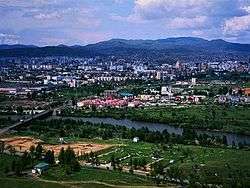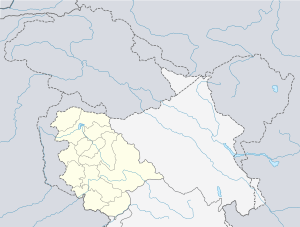Anantnag
Anantnag (/ə'nʌntna:g/ or /-nɑːg/ ![]()
Anantnag Islamabad | |
|---|---|
District | |
 Wide View of Anantnag | |
 Anantnag Location in Jammu and Kashmir  Anantnag Anantnag (India) | |
| Coordinates: 33.73°N 75.15°E | |
| Country | India |
| Union Territory | Jammu and Kashmir |
| District | Anantnag |
| Settled | 5 BCE |
| Area | |
| • Total | 2,917 km2 (1,126 sq mi) |
| Elevation | 1,601 m (5,253 ft) |
| Population (2011) | |
| • Total | 159,838[1] |
| Languages | |
| • Regional | Urdu, Kashmiri |
| Time zone | UTC+5:30 (IST) |
| PIN | 192 101 |
| Telephone code | 01932 |
| Vehicle registration | JK 03 |
| Sex ratio | 1000 ♂/927♀ |
| Literacy | 76.17%[1] |
| Website | anantnag |
Etymology
The name Anantnag is thought to originate from the Sanskrit term ananta, meaning "infinite", and Kashmiri word nāga, "water spring"; Anant-nāg would thus mean "numerous springs", as there are indeed many springs in the town. According to Marc Aurel Stein, however, the name of the city comes from the name of the spring of Shesha Nag, the "Divine Serpent" in Hindu theology, who was also called Anantnag; the spring located in the town.[3]
The name Islamabad is believed to have derived from the name of a Mughal governor Islam Khan who built a garden in the area.[4][5]
Both names are used for the town, Anantnag being preferred by the Hindus and Sikhs and Islamabad being preferred by the Muslims. The district surrounding the town was called Islamabad district until the 1950s when it was changed to Anantnag district. The locals continue to use the name Islamabad, even though the Indian security forces deployed in the area with the start of Kashmir insurgency frowned on its use.[2][4][6]
Geography
Anantnag is located at 33.73°N 75.15°E,[7] at an elevation of 5,300 feet (1,600 m) above sea level, at a distance of 53 kilometres (33 mi) from Srinagar on NH 44 (former name NH 1A before renumbering of all national highways).
| Climate data for Anantnag (1971–1986) | |||||||||||||
|---|---|---|---|---|---|---|---|---|---|---|---|---|---|
| Month | Jan | Feb | Mar | Apr | May | Jun | Jul | Aug | Sep | Oct | Nov | Dec | Year |
| Average high °C (°F) | 7.3 (45.1) |
8.4 (47.1) |
14.0 (57.2) |
20.5 (68.9) |
24.5 (76.1) |
29.6 (85.3) |
30.2 (86.4) |
29.8 (85.6) |
27.3 (81.1) |
22.2 (72.0) |
15.1 (59.2) |
8.2 (46.8) |
19.7 (67.5) |
| Average low °C (°F) | −2.1 (28.4) |
−0.9 (30.4) |
3.4 (38.1) |
7.9 (46.2) |
10.9 (51.6) |
14.8 (58.6) |
18.3 (64.9) |
17.2 (63.0) |
12.1 (53.8) |
5.8 (42.4) |
−0.1 (31.8) |
−1.4 (29.5) |
7.3 (45.1) |
| Average precipitation mm (inches) | 47 (1.9) |
69 (2.7) |
122 (4.8) |
88 (3.5) |
67 (2.6) |
36 (1.4) |
61 (2.4) |
77 (3.0) |
31 (1.2) |
33 (1.3) |
32 (1.3) |
54 (2.1) |
717 (28.2) |
| Average precipitation days (≥ 1.0 mm) | 7.0 | 8.3 | 11.1 | 8.2 | 8.2 | 5.9 | 7.7 | 6.6 | 3.5 | 3.1 | 3.0 | 5.9 | 78.5 |
| Source: HKO[8] | |||||||||||||
Demographics
From 2001 to 2011, the population of the city grew from 63,437[9] to 109,433,[1] while the metropolitan area (Anantnag Urban Agglomeration) grew to 159,838 by 2011.[1] In Anantnag city, males constituted 51.6% and females 48.4% of the population. Sex ratio was 937 females per 1,000 males compared to national average 940. The sex ratio was worse at 874 for the 0 to 6-year age-group compared to national average 918. Anantnag had an average literacy rate of 62.2%, lower than the national average of 64.3%. Male literacy was 71%, and female literacy was 61%. Children under six years of age numbered 18,056 in Anantnag city and were 16.6% of the population in 2011.[1]
Sites
The Martand Sun Temple is one of the important archaeological sites of Kashmir. It was built around 500 CE. This temple has the typical Aryan structure as was present in Aryan Kashmir. The Martand temple is situated at Kehribal, 9 km east-north-east of Anantnag and south of Mattan. This famous Sun Temple was destroyed by Muslim Ruler namely Sikander Buthshikan of Shahmiri Dynasty and took him more than a year to destroy this temple. This was one of the first brutal attacks on Kashmiri Hindu society by a Muslim Invader.[10]

Masjid Baba Dawood Khaki is among the oldest mosques in the city, being built around 1400 CE.[10]
Economy
In 2010 Anantnag was declared as major City of Export excellence with a total GDP of 3.7 billion $.[11] The high GDP of Anantnag is due to the centralised position and presence of high concentration of troops and migrant labours in it. Anantnag has a strategic position lying on the main North-South Corridor Road and with the highest number of tourist destinations it an economic hub of Kashmir Valley. The city suffered heavily during conflict times of the 1990s; many roads, bridges, and government buildings were reduced to ash. But in the 2000s, it made a quick recovery. It has been listed among 100 fastest economically developing cities.[11]
Transport
Road
Srinagar is 53 km from Anantnag on NH 44 (former name NH 1A before renumbering of all national highways). The distances of some other towns from Anantnag are: Achabal 10 km, Kokarnag 23 km, Doru Shahabad 20 km and Pahalgam 39 km.[12] The city is served by National Highway 44. The city is gateway to the Kashmir valley as one side of Jawahar Tunnel opens here.
Rail
Anantnag(ANT) is a station on the 119 km (74 mi) long Banihal-Baramulla line that started in October 2009 and connects Baramulla(BRML) and Srinagar to Banihal(BAHL), Qazigund .The railway track also connects to Banihal across the Pir Panjal mountains through a newly constructed 11 km long Banihal tunnel, and subsequently to the Indian railway network after a few years. It takes approximately 9 minutes and 30 seconds for a train to cross the tunnel. It is the longest rail tunnel in India. This railway system, proposed in 2001, is not expected to connect the Indian railway network until 2017 at the earliest, with a cost overrun of 55 billion INR. The train also runs during heavy snow across the Kashmir Valley.
Education
There are numerous primary, middle secondary and higher secondary schools in the city. Of the higher education, the following establishments are notable:
- University of Kashmir South Campus, Anantnag
- Government Medical College, Anantnag
- Industrial Training Institute, Anantnag
- Government Women's College, Anantnag
- Al Ahad College of Education, Anantnag
- Jamia College of Education, Anantnag
- Government Polytechnic College, Anantnag
References
- "Anantnag City Census 2011 data". Archived from the original on 5 May 2012.
- Bhat, M. Ashraf (2017), The Changing Language Roles and Linguistic Identities of the Kashmiri Speech Community, Cambridge Scholars Publishing, p. 57, ISBN 978-1-4438-6260-8
- "Ananta Shesha". www.speakingtree.in. Retrieved 13 June 2018.
- "Anantnag or Islamabad? What is the actual name of this South Kashmir district?". Kashmir Watch. 15 February 2018. Retrieved 28 March 2018.
- Ahmad, Khalid Bashir (2017), Kashmir: Exposing the Myth behind the Narrative, SAGE Publishing India, pp. 201–, ISBN 978-93-86062-81-9
- "What is in a name – Islamabad". kashmirdispatch.com. Retrieved 28 March 2018.
- Falling Rain Genomics, Inc – Anantnag. Fallingrain.com.
- "Climatological Information for Srinigar, India". Hong Kong Observatory. Retrieved 2 May 2011.
- "Census of India 2001: Data from the 2001 Census, including cities, villages and towns (Provisional)". Census Commission of India. Archived from the original on 16 June 2004. Retrieved 1 November 2008.
- "Places To Visit In Anantnag". Holidify Pvt Ltd.
- "Centre declares Srinagar, Anantnag as 'Export Excellence towns'". The Economic Times. 1 December 2010. Archived from the original on 12 February 2018.
- "Anantnag Pin code". citypincode.in. Retrieved 20 March 2014.
External links
| Wikimedia Commons has media related to Anantnag. |
| Wikiquote has quotations related to: Anantnag |

- Articles about Anantnag in The Economic Times